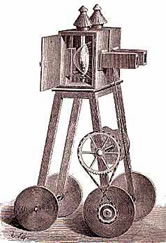Part A:
Etienne-Gaspard Robert
Etienne-Gaspard Robert was born in 1763 in the city of Liege, Belgium. He studied at Leuven and became a physic
s professor, specializing in optics. An avid painter, he moved to Paris in the 1790s so that he could pursue his career in art. While there, he made a living as a painter and draughtsman while attending lectures in natural science at the College de France and lectures by Jacques Charles. Throughout the 1790s and the early 19th century, Robert researched various areas of physics and gave public demonstrations about galvanism (the induction of electrical current from a chemical reaction) and optics. In 1793 Robert attended a magic lantern show by Paul de Philipsthal. After seeing this show, Robert realised the potential of what would later become “phantasmagoria.” Robert enjoyed reading the works of 17th century scholar Althanasius Kircher, and was especially fascinated by the magic lantern, an early form of the slide projector. Robert invented his own version of the magic lantern with multiple improvements, including: adjustable lenses and a moveable carriage system. These allowed the operator of the device to changed the size of the projected image. Robert also found out how to project multiple images at once using more than one glass slider. The image displayed could then have a rather ghostly effect in a smoky atmosphere. After much wo
rk and some additional refinements, he received a patent for what became known as the Fantoscope. Robert then used this new invention in his own phantasmagoria shows, involving actors and ventriloquists alongside of the Fantoscope’s projections. Using projections onto larges pieces of wax-coated gauze, smoke, mirrors, and his own painting skills,
Robert was able to make “ghosts” appear. His first show was on January 23, 1798 and he continued making it more elaborate. His shows were eventually performed around the world in Russia, Spain, and the United States.
I think that Robert's invention is a great example of early photography. Robert saw the potential of image projections as a form of art. Robert's invention, along with others of the time, probably had a profound influence on drawing people's attention to the potential to capture images and project them for viewing.
Here is a link to the Wikipedia article about Etienne-Gaspard Robert.



Part B:
Here is a link to an excellent article and a Picture History : Alexander Gardner website with many pictures taken by Alexander Gardner. Alexander Gardner took some of the best Civil War pictures, many of which are used to illustrate Civil War history books. His pictures are a great reminder of how terrible the Civil War was. By taking photographs so early on in photography's history, Gardner provided valuable information about the Civil War that no one can get by just reading about it. His pictures give a message that mere words cannot express.
I love the illustrations of Robert's slide projections. Can you imagine the fear in the audience?
ReplyDelete